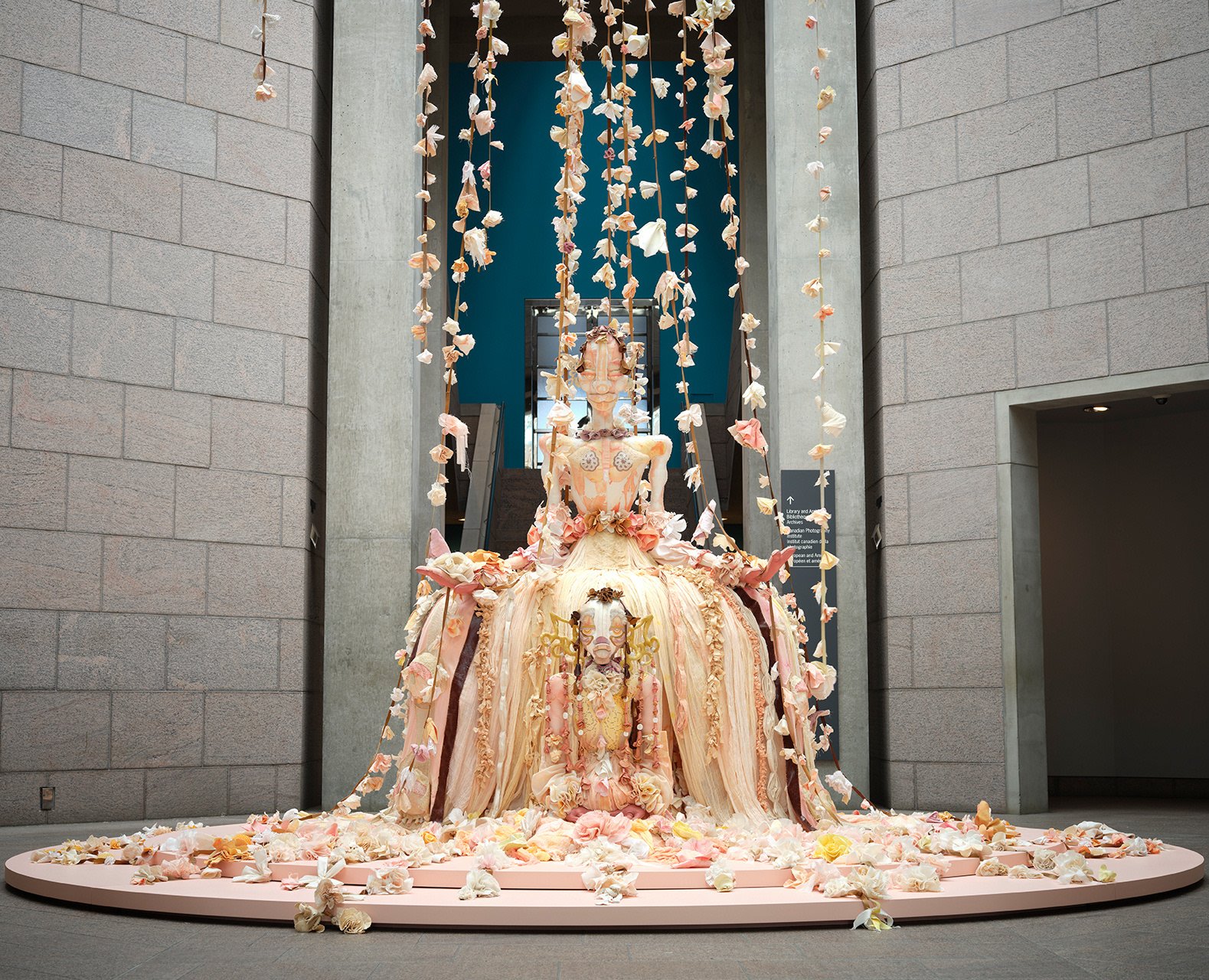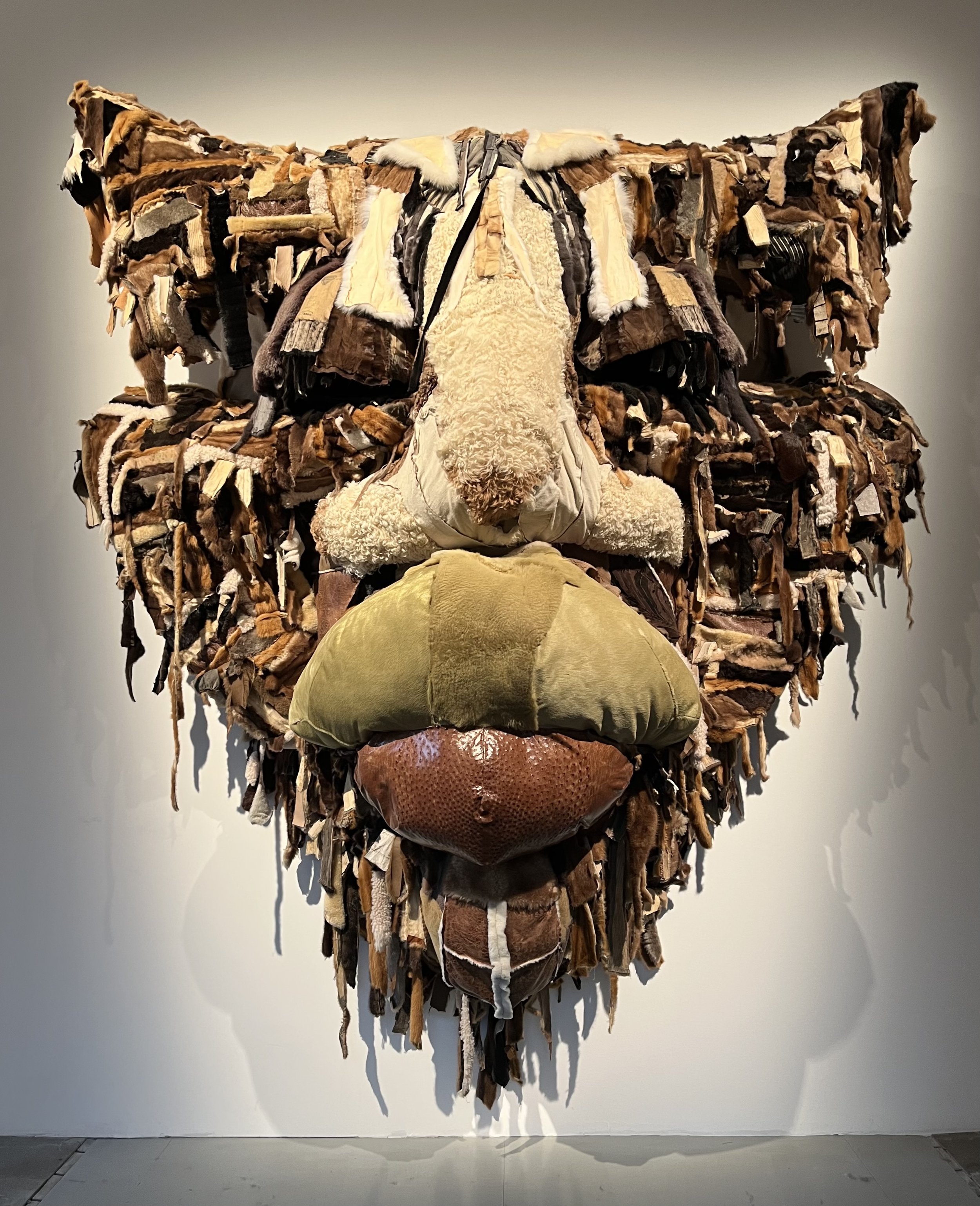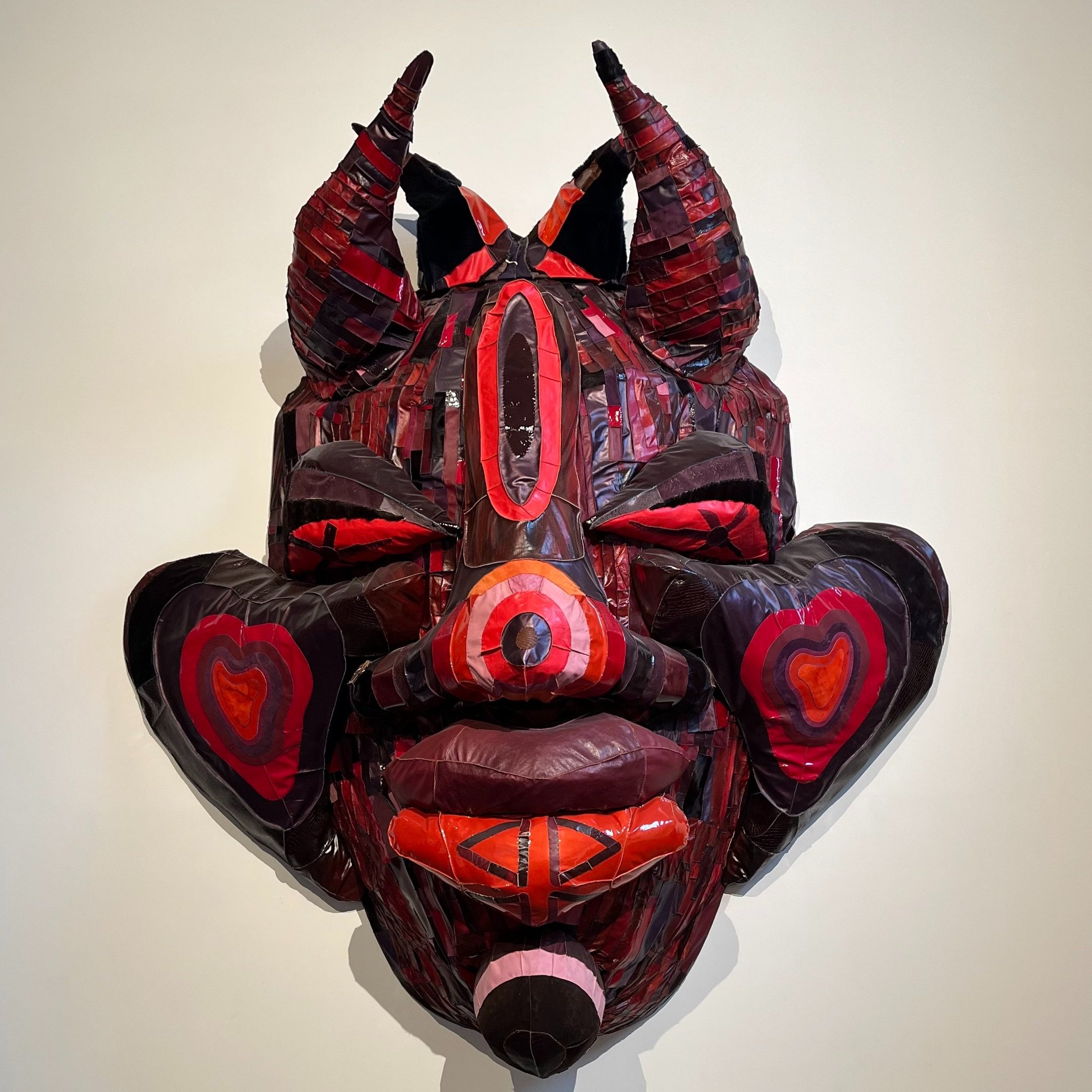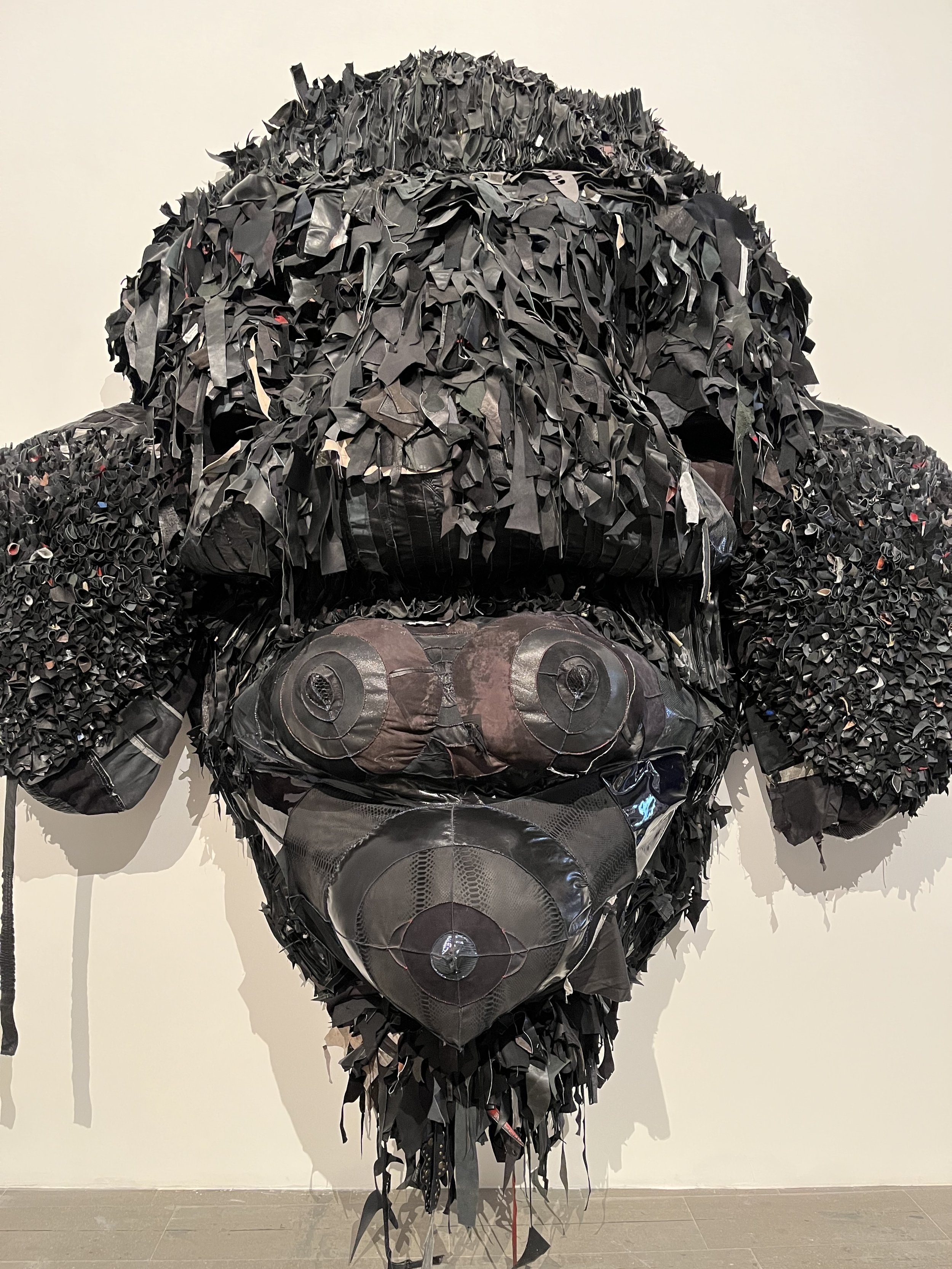Artists You Should Know: Tau Lewis
To come upon the sculpture titled The cure will be completed in my body, silence your spirit to let me reach you, my skin will secrete angels and you will have forgotten and forgiven all, (2023) currently installed in the ground floor gallery of the Institute of Contemporary Art Miami, is to be thrust into a state of wonder.
The sculpture’s seemingly infinite layers; the tactile mix of leather, fabric, shells and fur; the unique colors; the massive scale; the lips and eyes; the dainty earrings – come together to send you into a state of thrilling mystification. What is this assemblage of material, color and labor? How does it radiate its distinct, compelling energy? What world have I entered? Is this a beast, a spirit, a deity? How was it made and what does it mean?
Tau Lewis, The cure will be completed in my body, silence your spirit to let me reach you, my skin will secrete angels and you will have forgotten and forgiven all. (2023). Installed at the ICA Miami. © Tau Lewis. Photo, Robin Hauck.
Welcome to the inventive universe of Tau Lewis, a Canadian-born artist with Jamaican roots whose work honors and contemporizes the creative traditions of the African and Caribbean diaspora. This piece, emblematic of her wider practice, earned Lewis the prestigious Ezratti Family Prize for Sculpture from the museum, the first major institution to add Tau Lewis to their collection. Their purchase was a quilted tondo (a circular work of art) titled “The Tongue and the Teeth” (2020) which was shown at Prospect New Orleans in 2021.
Using found materials of all kinds, Lewis makes sculptures, installations and wall hangings that envelope the viewer, sometimes like a hug, sometimes like a call to attention. Her desire to create environments of optimism, imagination, care and beauty rests on a commitment to honoring ancestral memories, supporting Black histories and encouraging utopian futures.
“Blackness to me, at its root, is all about upcycling, of taking what’s there and making something more.””
Lewis employs labor-intensive, traditionally undervalued practices like hand-sewing, quilting,
appliqué and carving to create works of massive power from her collection of textiles and artifacts.
A treasure hunter and protector of the past, she looks for materials wherever she is: from bedsheets and table linens to salvaged leather, wire, pipes, shells, jewelry, fur, clothing and cast-offs.
At 82 inches tall, “The cure will be completed in my body, silence your spirit to let me reach you, my skin will secrete angels and you will have forgotten and forgiven all” radiates with the energy of its amassed elements: dyed leather, nylon string, the skin of a drum, fur, suede, fabrics, animal teeth, shells, pebbles, and steel armature.
In interviews, Lewis talks about the exchange of energy that occurs between herself, her source materials and the final object. She spends intense amounts of time with the materials while creating a new work, and draws their past lives, experiences and memories into her ever-evolving narrative.
“I’m interested in how I can honor and continue diasporic practices of art-making, which have been labor intensive and very focused on recycling and burning their own energy into the object.”
The first time I encountered a large-scale work by Tau Lewis was during the Prospect New Orleans biennial in 2021. The pure physicality and novelty of Delight demanded my full attention. That year, Prospect’s theme was inspired by New Orleans jazz musician Chief Xian aTunde Adjuah’s album Yesterday You Said Tomorrow, which considers an unspoken present - a time when the past meets the future and all possibilities exist.
This theme helped contextualize and emphasize Lewis’ ideas around sculpture’s ability to guide audiences toward an acknowledgement and better understanding of Black cultural traditions that have been omitted from western histories and canons.
As we see in our current political climate, meaningful cultural change happens at a glacial pace and is under constant threat of reversal. Stitch by stitch, confrontation by confrontation, Lewis and fellow sculptors like Kevin Beasley, Howardena Pindell, Bisa Butler and Betye Saar, persevere in imagining what that change could look like so that we can too. In the right hands, sculpture is hope.
Lewis’ Delight, like so much of her work, is an all encompassing experience. A serene, otherworldly figure sits on a swing held by ropes strewn with pink, yellow and light brown blossoms (the colors of a uterus). Part nostalgia, part fairy tale, part spirit guide, Delight drew me into a bright, surreal, sci-fi realm and helped me forget about the dark days of COVID isolation.
Installation view, Delight, Prospect 5 New Orleans 2021, Ogden Museum of Southern Art. © Tau Lewis. Photo: Robin Hauck.
Delight is part of a larger series of works that make up the utopian fictional universe T.A.U.B.I.S - The Triumphant Alliance of the Ubiquitous Blossoms of Incarnate Souls - that Lewis created during the pandemic. The works in this series represent mystical, non-gendered maternal figures who provide a space for care and nurturing founded on ancestral connection to the natural world and spiritual traditions. According to Lewis, each blossom adorning her figures represents an entity or soul that has lived a beautiful life. Blossoms appear in much of her oeuvre, including dangling from the ears of The cure will be completed in my body, silence your spirit to let me reach you, my skin will secrete angels and you will have forgotten and forgiven all.
Other well-known works from the T.A.U.B.I.S. series include Symphony which was exhibited at the National Gallery of Canada and Opus (The Ovule), depicting the monumental head of Opus, “the power source of consciousness” in Lewis’ fictional universe, exhibited in the Platform section of the Armory Show in 2021.
Tau Lewis, Symphony, 2020–21. Various recycled and hand-dyed fabrics, recycled leather, cotton batting, beads, acrylic paint, PVA glue, metal hoop skirt, pipe, seashells and wire. Purchased 2021. National Gallery of Canada, Ottawa. © Tau Lewis Photo : NGC. © Tau Lewis
Tau Lewis, Opus (The Ovule), 2020, recycled and hand dyed fabrics, recycled leather, acrylic paint, recycled polyester batting, jute, metal frame, PVA glue, secret objects, safety pins, metal hooks, wire. © Tau Lewis
Lewis’ design vocabulary incorporates ancient motifs that portray enduring African concepts and elegantly challenge western hegemonic ways of thinking. At Prospect, three tapestries that accompanied Delight included and were named after Ghanaian Adinkra symbols which date to prehistoric times. Her use of such symbols frame contemporary western social issues (such as choice, sex, motherhood and childbirth) within knowledge systems from the other side of the world. Just as the materials Lewis uses bring the energy of their past experiences into her assemblages, these symbols keep the past alive in her contemporary realm.
Tau Lewis, The Tongue and the Teeth (black) and Tree of God (white) both 2021, Installation view Prospect New Orleans 2021. © Tau Lewis. Photo, Robin Hauck.
By incorporating such African mythology in her design choices, Lewis conjures a rebellious and inclusive telling of the history that is being written today: we will not ignore the past, we will not forget what has transpired. This is part of our lived experience. This is our affective history. Her work helps white audiences understand the importance of such cultural influences and also insists upon it. Her sculptures become part of a vivid historical record written in textile and form.
Lotus headed fertility goddess, Lajja Gauri. Relief ca 6th century, India. Metropolitan Museum of Art.
At the center of The Tongue and the Teeth, the work acquired by the ICA Miami, an oculus of black and white shells from Lewis’ home country of Jamaica mark the womb as a sacred center of meaning making. Her figures, with feet spread wide, share similarities with the Hindu symbol of fertility Lajja Gauri.
Nods to Lajja Gauri also could be considered in two works exhibited in “Threadbare” at Stephen Friedman Gallery, London in 2021. Again Lewis makes new life from what already exists.
Threadbare (from left to right) The leg of the hen (2020), Dumah (2021), Harmony (2021) and sword of war (2020) installed at Stephen Friedman Gallery, London. © Tau Lewis
Sea Goddesses and mermaids feature prominently in Afro-Caribbean mythology. Think of Simone Leigh’s towering monument Sentinel (Mami Wata) which honors the goddess Mama Wata, installed on the site of the decommissioned statue to Confederate General Robert E. Lee in New Orleans. Fierce, protective of women, associated with water, fertility and lunar cycles, Mama Wata and the goddess known as Yemọja or Yemaya from the Yoruba religion, play important roles in the traditional belief systems Lewis references in her work.
Some of Lewis’ most stunning figures recall these mythical rulers of the deep. Take the sensuous, all-seeing Homonoia (2022) and Dainty the Mermaid, created in 2018, which sold at Sotheby’s in 2023 for 300% over the estimated selling price.
Homonoia, 2022. Steel, enamel paint, acrylic paint and finisher, repurposed leather and suede, organic cotton twill, coated nylon thread. © Tau Lewis. Courtesy the artist and 52 Walker, New York. Photo: Maris Hutchinson.
Dainty the Mermaid, 2018. Hand sewn fabrics, furs and leathers, hand carved plaster, acrylic paint, copper pipes, polyester stuffing, wire, concrete, seashells, stones and wooden chair. © Tau Lewis
For the 2022 Venice Biennale titled The Milk of Dreams, curated by Cecelia Alemani, Lewis created Divine Giants Tribunal, a series of epically scaled masks, each almost ten feet tall. These works also take inspiration from Yoruba tradition, in this case ceremonial masks, as well as the writings of Nigerian playwright Wole Soyinka.
From the La Biennale di Venezia website: “Her fantastical bodies grow as if from a handmade garden, protective vessels standing in opposition, as the artist has said, to the myth that there cannot be a nurturing and healing relationship between the Black body and the landscape.”
Tau Lewis is represented by Night Gallery.
* Cover Image: detail from “The cure will be completed in my body, silence your spirit to let me reach you, my skin will secrete angels and you will have forgotten and forgiven all,” (2023) Institute of Contemporary Art Miami. Photo: Robin Hauck.


















